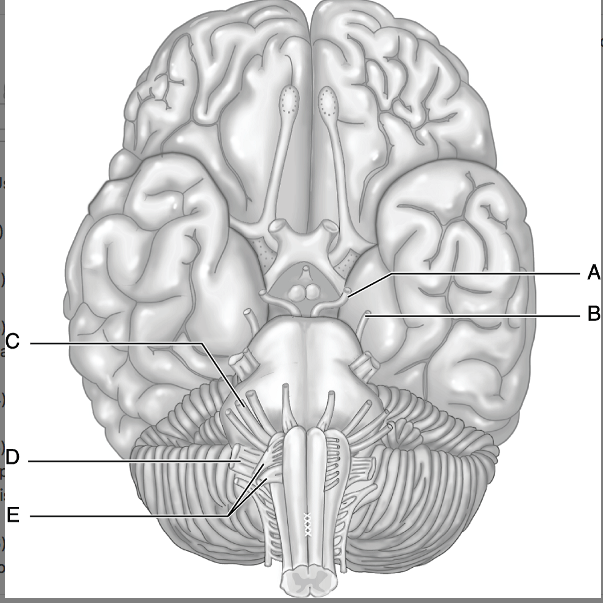
Using Figure 13.1, match the following:
1) Innervates the superior oblique muscle.
2) Longest cranial nerve.
3) Damage to this nerve would cause dizziness, nausea, and loss
of balance.
4) Involved in movement of the digestive tract.
5) Damage to this nerve would cause difficulty in speech and
swallowing, but no effect on
visceral organs.
6) Damage to this nerve would keep the eye from rotating inferolaterally.
1) Answer: B
2) Answer: D
3) Answer: C
4) Answer: D
5) Answer: E
6) Answer: B
Using Figure 13.2,
identify the following components of the
reflex arc:
7) Integration center.
8) Sensory neuron.
9) Effector.
10) Motor neuron.
11) Receptor.
Using Figure 13.2,
identify the following components of the
reflex arc:
7) Answer: E
8) Answer: C
9) Answer: B
10) Answer: D
11) Answer: A
12) Formed by the union of a
cranial and a spinal root.
13) Receptors located in
epithelium of the nasal cavity.
14) Serves the senses of hearing
and equilibrium.
15) Helps to regulate blood
pressure and digestion.
16) Turns the eyeball laterally.
A) Vagus
B) Olfactory
C) Accessory
D) Abducens
E) Vestibulocochlear
2) C
13) B
14) E
15) A
16) D
17) Tests both upper and lower
motor pathways. The sole of
the foot is stimulated with a
dull instrument.
18) Checks the integrity of the
spinal cord and dorsal
rami at
the level of T8 to T12.
19) Produces a rapid withdrawal
of the body part from a
painful stimulus; ipsilateral.
20) Prevents muscle
overstretching and maintains
muscle tone.
A) Stretch
B) Abdominal
C) Flexor
D) Plantar
17) D
18) B
19) C
20) A
2) A patient suffers nerve damage to the sciatic nerve, requiring
surgery to suture the nerve back
together. After surgery, the
patient reports that sensation from the lateral and medial sides of
the knee seem to be reversed. How could this happen?
Answer: In suturing the nerve back together, there is no guide to
ensure that each nerve fiber
continues across the transection
into the same neurilemma in which it started. Nerve
fibers can
grow into pathways different from their original ones and establish
new
synapses. The brain cannot keep track of which nerve fibers
have grown into different
pathways, and projects sensations back
to the point of origin.
3) David, an aspiring baseball player, was struck on the left side of
his face with a fastball pitch.
He was not wearing a safety
helmet. His zygomatic arch was crushed, as well as parts of the
temporal bone. Following the accident and reconstructive
surgery, he noted that his left lower
eyelid was still drooping
and the corner of his mouth sagged. What nerve damage did he
sustain?
Answer: He suffered facial nerve damage on his left side. Due to the
bone damage, branches to
the eye and jaw were probably damaged.
It is possible that the damage could be
reversible if the nerves
were not cut or crushed completely.
A nurse is asked about the cause of the excruciating pain of tic douloureux. How should s/he answer?
Answer: The excruciating pain is caused by inflammation of the
trigeminal nerve. Pressure on
the trigeminal nerve root can turn
normal stimuli like tooth brushing into painful
stimuli.